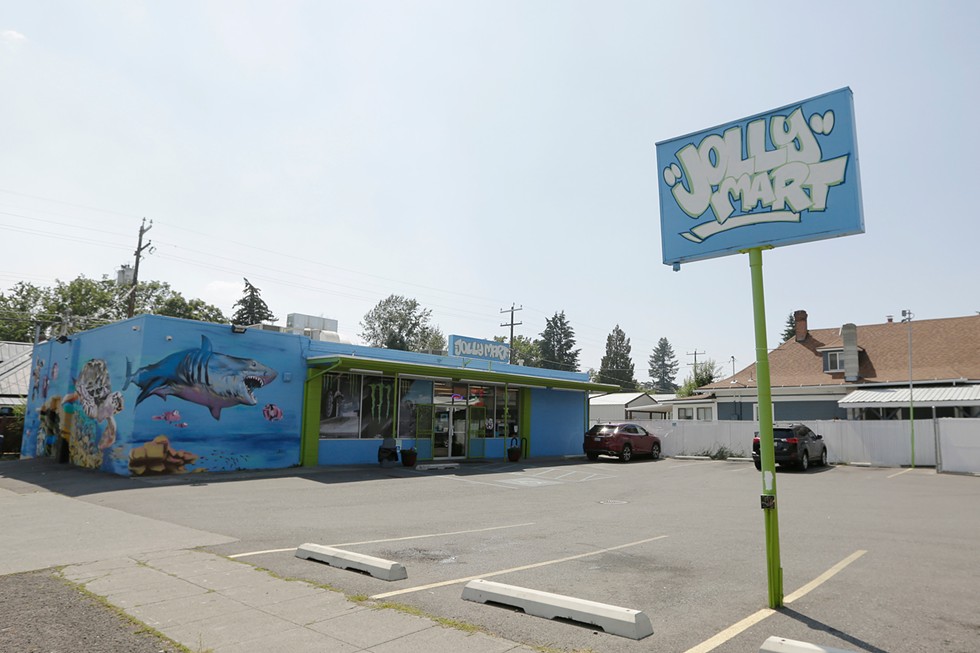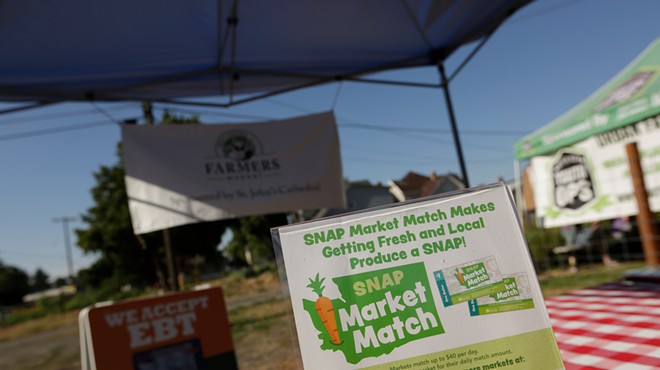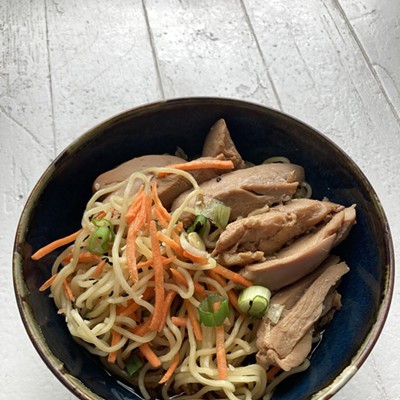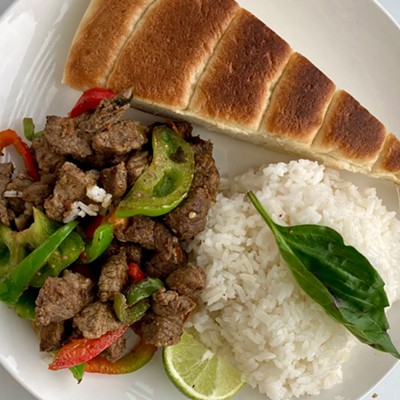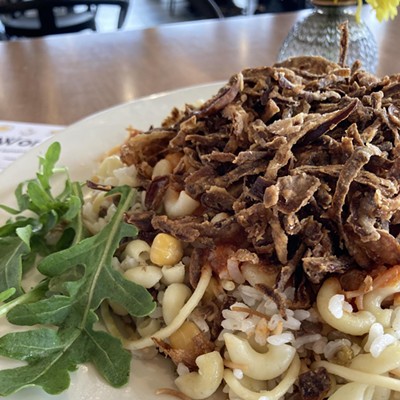Jolly Ghebreab walks into Jolly Mart, ready to run the register after single-handedly unloading a pallet of popsicles in 100-degree heat. He wears his red apron and jeans, his usual attire at the store his brother named for him.
To his left, typical convenience store items line the shelves: gummy candies, Hostess snacks, peanuts, jerky and Vitamin Water. To his right, however, are rows of canned goods, cereal, onions, avocados, oranges and freezers full of frozen meals.
The Ghebreab family owns Jolly Mart and nearby Bong's on Boone Avenue, two local convenience fixtures in Spokane's West Central neighborhood. They've lived in the neighborhood for over a decade, time that Ghebreab's also spent figuring out what's missing in his community.
"It's been hard for the neighborhood to have access to produce," he says.
West Central is historically one of the lowest income neighborhoods in Spokane and is vulnerable to many health injustices. The Environmental Protection Agency created an environmental justice mapping tool to track concerns like air pollution and hazardous waste levels across socioeconomic levels, but it also keeps a record of critical service gaps, like broadband and medical service gaps, plus "food deserts." The EPA designates West Central as a food desert, meaning most residents don't have access to nutritious food within a mile of their homes.
The U.S. Department of Agriculture likewise considers homes "food insecure" if they have "limited or uncertain access to adequate food." But it's not just about the amount of food someone can find; the USDA links food security to nutrition security, where a person has consistent access to affordable foods that "promote well-being, prevent disease, and, if needed, treat disease." In other words, eating enough calories isn't necessarily the same as eating a healthy diet.
Sure, plenty of people who are completely food-secure eat poorly. But there's a big difference between choosing an unhealthy diet and being forced into one because of where you live. Poor nutrition is the leading cause of illness in the United States, according to the USDA, and those living in food deserts are more at risk of diet-related diseases. Combating food deserts is about bringing equity to everyone's food decisions.
In 2020, almost a third of Washington families faced food insecurity, according to a Washington State Food Security Survey, including one-third of Spokane County families. West Central is one area struggling with food access, but it's hardly alone in the greater Inland Northwest. Portions of East Spokane, Hillyard, rural areas stretching from Orchard Prairie to Mead, the Kalispel and Coeur d'Alene reservations, and big swaths of Moscow, Idaho are all considered food deserts by the EPA. And West Central is a good case study in the ongoing efforts undertaken and the daunting challenges these communities face in trying to make food accessible for its residents.
Some relief trickles into West Central in the form of fresh produce at convenience stores like Jolly Mart and Bong's, since they provide basic nutrition at a walkable distance for the neighborhood. But factors like income and community perception can impact food insecurity even more than distance. While efforts like food education and urban agriculture have limited direct impacts on food security, they significantly improve community involvement and identity among residents, which are also key characteristics of public health. Working together to address these various aspects of food insecurity, businesses, community members and nonprofit agencies are trying to turn this food desert into a well-fed urban oasis.
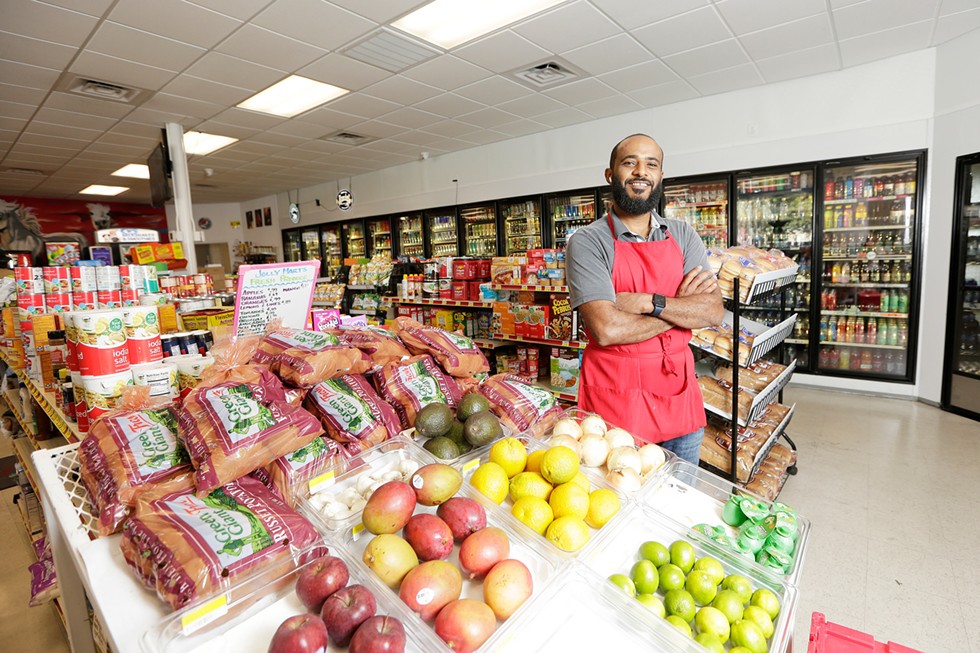
SHRINKING OPTIONS
Usually, a big service gap means a great business opportunity. Think of how well a lemonade stand would do on a long stretch of the Centennial Trail in August. So why don't grocery stores open in neighborhoods with little to no access to fresh food?
The whole model for the food market has changed, according to Pablo Monsivais, an associate professor in the Department of Nutrition and Exercise Physiology at Washington State University. Grocery stores operate on "skintight profit margins," he says, which prompts markets to consolidate into bigger stores. These supermarkets then move to arterial roads to increase the amount of traffic to their stores. Monsivais says it's common for multiple supermarkets to be located close to each other. Though it seems counterintuitive, it actually increases the density of customers in the area and the amount of people in each store.
These economic incentives drive local grocers out of neighborhoods, especially low-income neighborhoods where profits are even skimpier due to surrounding families' lower food budgets and higher rates of shoplifting.
"Unfortunately, what's good for business is not always good for public health," Monsivais says.
West Central has long experienced such economic abandonment.
There's been a "decades-long process of systemic divestment from this neighborhood," according to Elizabeth Marlin, the chair of the West Central Neighborhood Council. In 2020, the community lost Broadway Market, a local grocer with a modest offering of essentials. In 2012, when the owner of Clancy's Produce was killed in a car accident, no one took over his local stand offering fresh fruits and veggies to the community.
Marlin is used to carpooling with neighbors to Walmart or WinCo at the start of each month to stock up on a 30-day supply of dry goods and other essentials. The nearest Walmart is about 2½ miles from the heart of West Central, while WinCo is over 6 miles away. Despite the distance and rising gas prices, these are the best options for what Marlin and her family need, like bulk bags of flour or multipurpose cuts of meat.
"I know what it's like to stretch a dollar," says Marlin, a single mother and foster parent.
My Fresh Basket opened in 2017, and is only a mile from the middle of West Central. It has a coffee bar, a bakery and a deli, and lots of specialty local items. When customers walk through the doors, they're often greeted by a security guard and rows of beautiful fruit and vegetables. A breakfast bar and salad bar are just past the avocados.
If food deserts are simply determined by distance to a grocer, My Fresh Basket's location on the edge of West Central would clear the EPA's label from the neighborhood. Yet, the issue of food insecurity in the neighborhood remains.
"Is [My Fresh Basket] solving food accessibility?" Marlin asks. "No." Then she continues, "But I don't expect it to."
The Kendall Yards development has taken over the south edge of West Central, where it links to downtown Spokane. Its apartments and high-end housing bring a greater income diversity to the community. Though some long-term West Central residents view the addition as an intrusion, Marlin doesn't agree.
"Kendall Yards is not a bad thing," she says. "They're not the other side. They're part of our neighborhood."
She has the same attitude toward My Fresh Basket. It's simply a grocery store that serves some needs and not others. It serves a lot of employees in Kendall Yards and downtown who are looking for healthy, quick lunches. Marlin also says My Fresh Basket has made a conscious effort to serve a variety of customers, and prices on things like hamburger, produce and chicken are sometimes comparable to other grocery stories. She can stop by if she's in a rush and needs to supplement her regular supplies. But it's only helping her fill in the cracks.
"Can I afford to do my weekly grocery shopping there? Hell no," Marlin says.
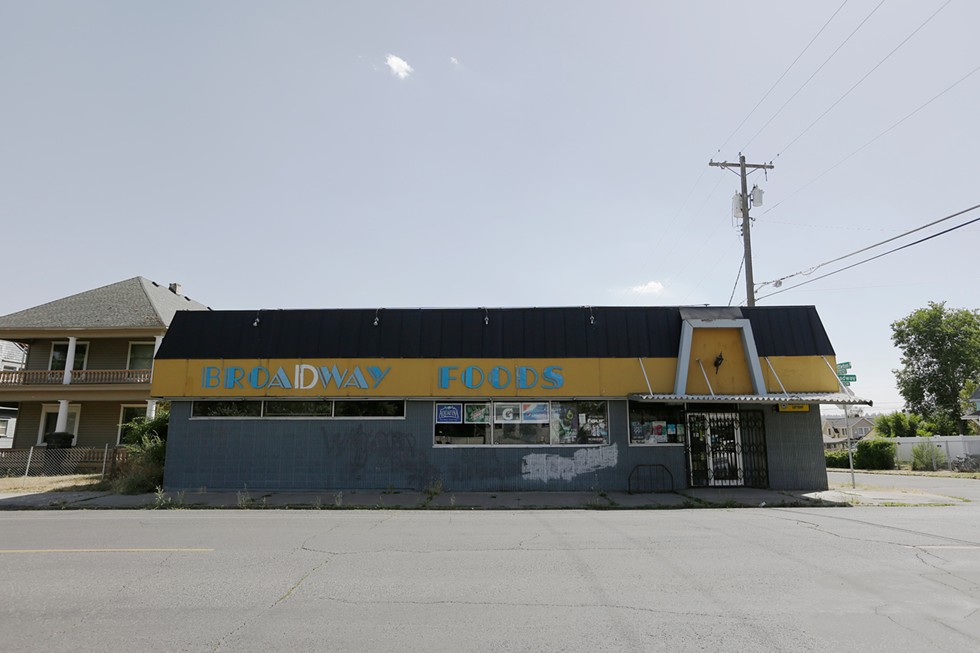
PERCEPTION MEETS REALITY
When Greenstone, the developer behind Kendall Yards and other planned neighborhoods around Eastern Washington, mapped out the new community, founder Jim Frank noted the need for a nearby grocery. He said the store was intended to serve people in a 2- to 3-mile radius, from West Central to other neighborhoods like downtown's Riverside, and Emerson-Garfield a little further north.
"I would like to see the day when groceries are more accessible, where you don't have to drive 4 to 5 miles to the grocery store," Frank says.
The store does a lot to address customer needs, according to Frank. If people think the store is too expensive for them, "I don't think they've looked at the prices," he says.
A gap exists between My Fresh Basket's mission and some of the community's perception of the place, though. This illuminates an evolving understanding of food deserts. First, the USDA deemed a neighborhood a food desert if it was isolated by distance. Then, they expanded the definition — if people couldn't afford groceries at the store near their house, they were left with only a mirage, still stuck in a food desert. Now, it's evolving even more to consider the community's perception of the store, and whether they feel the store is intended for them or not.
A 2014 research study in Philadelphia highlighted the importance of customer perception. A new grocer opened in an underserved area, yet buying patterns in the community didn't change. Researchers suggested that building a new store isn't enough to help people buy more fresh food. Appropriate branding and marketing may be just as necessary as affordable pricing to increase local consumption of produce and nutritious foods.
The things at My Fresh Basket that might be attractive to one part of the community — a hot bar, specialty foods — don't necessarily draw food insecure families into the store. Whether because of prices or branding, Ghebreab and Marlin say most West Central residents don't shop there. As West Central diversifies in income, Marlin thinks it needs to diversify resources, too.
"We don't need My Fresh Basket to lower prices," Marlin says.
Instead, in her mind, the community needs another grocer to serve a whole different community.
WON'T YOU BE MY NEIGHBOR
Typically, you don't run to the gas station to pick up a bag of potatoes. But at Bong's, a place where you can fill your tank and grab a lottery ticket, the previous owner was dedicated to carrying some grocery staples in her store. Now that the Ghebreab family owns and operates the shop, they've kept her legacy alive and added their own array of fresh foods.
"No matter what, we need to carry produce and essentials so everyone has access to basic nutrition," Ghebreab says.
He sees a lot of elderly ladies in Bong's and Jolly Mart, plus kids who come by after school for a free banana on Fridays. Some neighbors fill up a few bags of groceries each week. Most people don't come regularly for produce, he says, but if they forget something during their regular grocery run or are suddenly missing an ingredient, they're delighted to find it at his shops.
Carrying produce is a financial risk and not especially lucrative, Ghebreab says. Small stores with small orders can't get the wholesale discounts that large vendors can. He does a lot of loading and unloading himself to cut down on delivery costs. Produce doesn't have a long shelf life and has to be thrown away if people don't buy it in time, unlike processed snacks.
But Ghebreab doesn't consider profit his main goal.
"This is our neighborhood now," he says. He wants to make sure kids have access to fruit, not just candy. He says it makes him feel better when customers are surprised and happy with his wide selection of goods. When customers are smiling, "we know it was worth it," says Ghebreab.
Natalie Tauzin, a Healthy Eating Policy and Systems Specialist for the Spokane Regional Health District, did research on the effect of produce in corner stores on the health of the community. And despite the good intentions of business owners like Ghebreab, she says it's unlikely that some apples and garlic in Jolly Mart will significantly impact food security in West Central.
However, Ghebreab has dreams that may have a much bigger effect. He and his brother plan to demolish and rebuild Broadway Market into a full-service grocery store. Other chains have shied away from the old building because it's not big enough for the typical 10,000-square-foot footprint of a modern grocery, and it has very limited parking. Other potential operators may not want to deal with the shoplifting issues that often crop up in low-income neighborhoods. Jolly Mart loses about $3,000 to $4,000 a month due to stolen goods, Ghebreab says.
Once the Ghebreabs bought the Broadway lot, the pandemic interrupted their progress. City processes slowed down. It took 20 months to simply get approval on the initial architectural plan. Now, building costs have skyrocketed and contractors are booked. But the brothers have dedicated themselves to being patient and flexible.
Ghebreab needs to make money to support himself and his store, but ultimately his goals for West Central are different. He wants to improve the neighborhood and is willing to do so at a certain personal cost.
"The thing that makes change is not your profit," he says, "but the change that you've done."
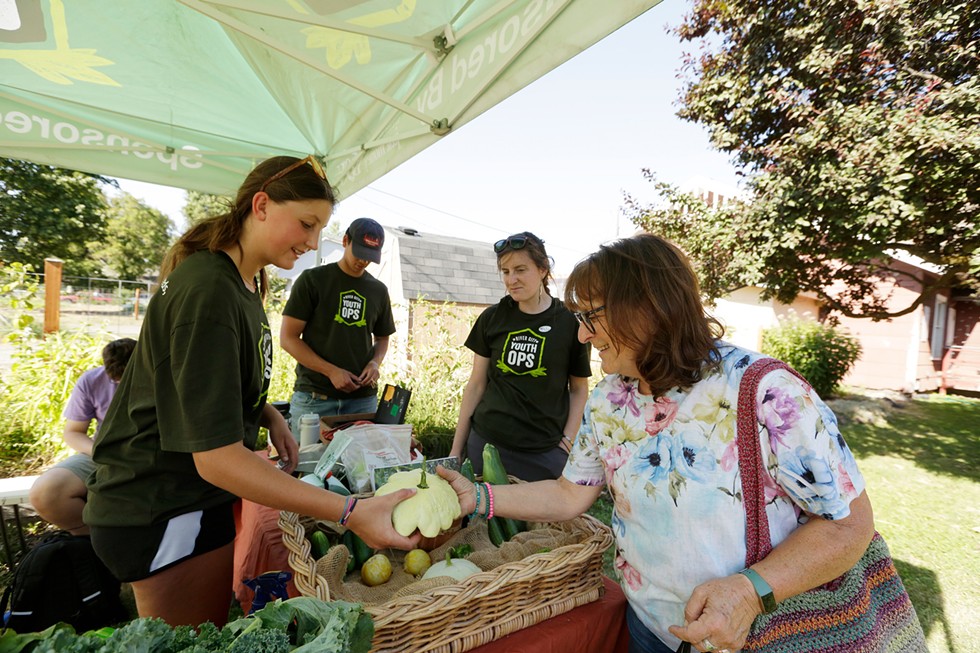
COMMUNITY CONNECTIONS
Marlin, the West Central Neighborhood Council chair, grows more tomatoes in her backyard than she can use. So she trades them with her neighbor for fresh cherries. Then she bakes them into a cherry tart.
Urban agriculture refers to food grown in a metro area, whether it be in someone's backyard or a community garden plot. Even though it has a modest impact on food security at best, it's helpful for other reasons, says Eric Williams, director of Second Harvest's Community Partnerships program.
"We love it when people bring fresh produce from their backyard," Williams says. Large-scale farmers are amazingly generous, he says, but often donate big amounts of a single crop. Community fruits and veggies help provide a variety of foods for families in need.
According to Tauzin at the SRHD, a quarter-acre of food crops in the city can produce enough vegetables for about six people, at best. This doesn't really improve diet quality or variety for more than one family. But setting aside land for food instead of development is really healthy for the soil and the environment, Tauzin says, not to mention the people nearby.
"Community gardens are really helpful for the physical and mental health of the people who work them," Tauzin says. They can also give immigrants the opportunity to grow familiar food and meet other people. But having enough space to designate a community garden can end up "being an elitist thing" if the neighborhood isn't careful.
River City Youth Ops is an organization at the West Central Abbey that hosts teenagers from surrounding areas to provide job and résumé training while farming a plot of land from seed to harvest. The Youth Ops grows kale, peas, beets, squash, garlic and herbs, as well as flower bouquets. Produce is then sold at a weekly farmers market, with excess veggies donated to local food banks.
Teen volunteers sell to everyone, from young families with children to elderly neighbors.
"Walmart is far away," says Justice, a 16-year-old River City Youth Ops participant. "This helps provide for people who can't always go to the grocery store."
WSU professor Monsivais emphasizes that urban agriculture helps mainstream and normalize gardening, which exposes children to different, and more nutritious, foods early in their lives. It's hard to get someone to eat beets if they've never seen one or if their palate is accustomed to processed, sugary foods.
Stephanie Watson is the River City Youth Ops program director. She dedicates herself to connecting young people to food and the environment where it grows.
"We all deserve food from the ground," Watson says. "If you don't see yourself as part of the environment, of course you're not going to put effort into getting access to it." Even if urban agriculture doesn't dent food insecurity, it promotes healthy habits to everyone who walks by.
"Just seeing it creates so much wonder," she says.
WORKING TOGETHER
West Central isn't the only part of Spokane facing food and nutrition insecurity, or finding unique ways to sow opportunity in a food desert. More work needs to be done to center the voices of people in the community finding new ways to feed themselves and their families. Sometimes, people who would qualify as "food insecure" don't consider themselves as such.
"I am of the mindset that how we frame things matters," says Watson of River City Youth Ops. "Creating this binary of 'haves' and 'have-nots' isn't helpful."
Both Watson and Monsivais stress the need for equitable decision-making. Food can create a more level playing field, according to Watson.
Watson and Marlin are optimistic that as West Central changes, the diversified income of its residents and more resources can improve equity instead of increasing hostility — if the community works toward knowing one another and growing together.
Though the Health District's Tauzin focuses on government policies and systemic issues, she recognizes the outsized impact that small, local acts of support can have on big, complex problems. Shrinking food deserts means not deserting each other.
"One of the most important things we can do as a society," says Tauzin, "is be there for our neighbors." ♦

